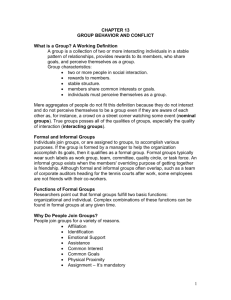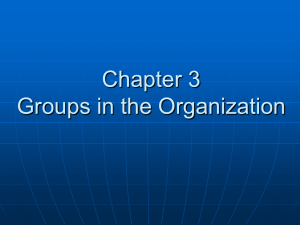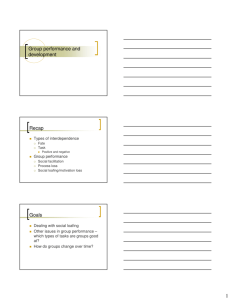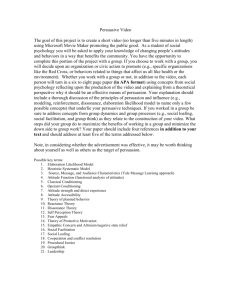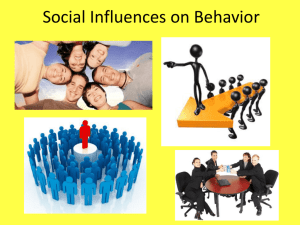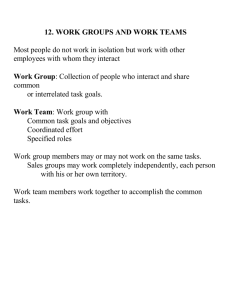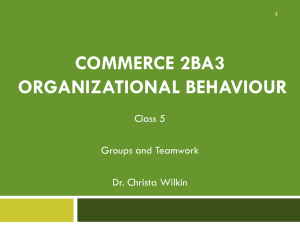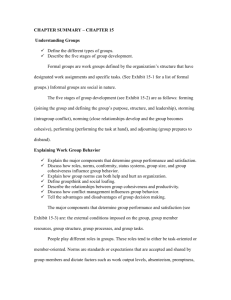Notes
advertisement
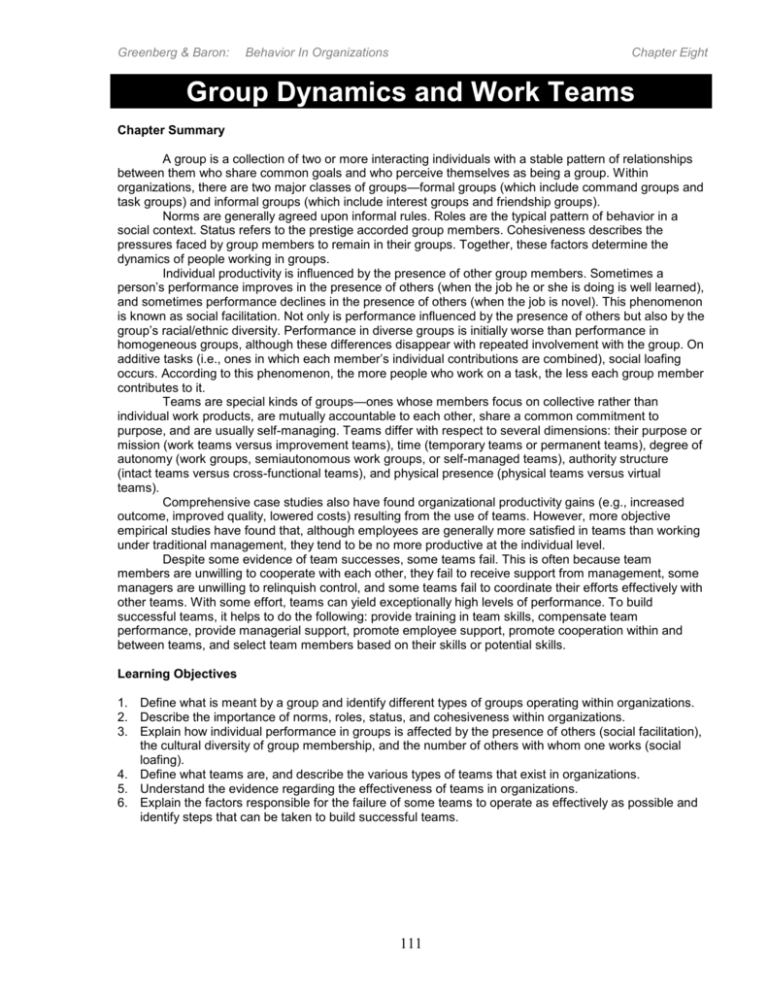
Greenberg & Baron: Behavior In Organizations Chapter Eight Group Dynamics and Work Teams Chapter Summary A group is a collection of two or more interacting individuals with a stable pattern of relationships between them who share common goals and who perceive themselves as being a group. Within organizations, there are two major classes of groups—formal groups (which include command groups and task groups) and informal groups (which include interest groups and friendship groups). Norms are generally agreed upon informal rules. Roles are the typical pattern of behavior in a social context. Status refers to the prestige accorded group members. Cohesiveness describes the pressures faced by group members to remain in their groups. Together, these factors determine the dynamics of people working in groups. Individual productivity is influenced by the presence of other group members. Sometimes a person’s performance improves in the presence of others (when the job he or she is doing is well learned), and sometimes performance declines in the presence of others (when the job is novel). This phenomenon is known as social facilitation. Not only is performance influenced by the presence of others but also by the group’s racial/ethnic diversity. Performance in diverse groups is initially worse than performance in homogeneous groups, although these differences disappear with repeated involvement with the group. On additive tasks (i.e., ones in which each member’s individual contributions are combined), social loafing occurs. According to this phenomenon, the more people who work on a task, the less each group member contributes to it. Teams are special kinds of groups—ones whose members focus on collective rather than individual work products, are mutually accountable to each other, share a common commitment to purpose, and are usually self-managing. Teams differ with respect to several dimensions: their purpose or mission (work teams versus improvement teams), time (temporary teams or permanent teams), degree of autonomy (work groups, semiautonomous work groups, or self-managed teams), authority structure (intact teams versus cross-functional teams), and physical presence (physical teams versus virtual teams). Comprehensive case studies also have found organizational productivity gains (e.g., increased outcome, improved quality, lowered costs) resulting from the use of teams. However, more objective empirical studies have found that, although employees are generally more satisfied in teams than working under traditional management, they tend to be no more productive at the individual level. Despite some evidence of team successes, some teams fail. This is often because team members are unwilling to cooperate with each other, they fail to receive support from management, some managers are unwilling to relinquish control, and some teams fail to coordinate their efforts effectively with other teams. With some effort, teams can yield exceptionally high levels of performance. To build successful teams, it helps to do the following: provide training in team skills, compensate team performance, provide managerial support, promote employee support, promote cooperation within and between teams, and select team members based on their skills or potential skills. Learning Objectives 1. Define what is meant by a group and identify different types of groups operating within organizations. 2. Describe the importance of norms, roles, status, and cohesiveness within organizations. 3. Explain how individual performance in groups is affected by the presence of others (social facilitation), the cultural diversity of group membership, and the number of others with whom one works (social loafing). 4. Define what teams are, and describe the various types of teams that exist in organizations. 5. Understand the evidence regarding the effectiveness of teams in organizations. 6. Explain the factors responsible for the failure of some teams to operate as effectively as possible and identify steps that can be taken to build successful teams. 111 Greenberg & Baron: I. Behavior In Organizations Chapter Eight Notes GROUPS AT WORK: THEIR BASIC NATURE A. WHAT IS A GROUP? A WORKING DEFINITION 1. Social scientists formally define a group as a collection of two or more interacting individuals, with a stable pattern of relationships between them, who share common goals and perceive themselves as being a group. Figure 8.1 p.273 2. Four key characteristics of groups: Social interaction. Group members must have some influence on each other. This interaction between the parties may be verbal (e.g., sharing strategies for a corporate takeover) or nonverbal (e.g., exchanging smiles in the hallway), but the parties must affect each other to be considered a group. Stability. Groups also must possess a stable structure. Groups can-and often do-change, but there must be some stable relationships that keep the members together and functioning as a unit. Common interests or goals. Members share common interests or goal. Recognition as being a group. The individuals involved must perceive themselves as being a group. Groups are composed of people who recognize each other as being members of their group and who can distinguish members from nonmembers. B. TYPES OF GROUPS Figure 8.3 p.273 1. Formal and informal groups. a. Formal groups are created by the parent organization and are intentionally designed to direct members toward some important organizational goal. b. A command group is a group determined by the connections between individuals who are formal members of the organization. c. A formal organizational group also may be formed around some specific task. Such a group is referred to as a task group. d. Unlike command groups, task groups may include individuals with some special interest or expertise in a specific area, regardless of their positions in the organizational hierarchy. 112 Greenberg & Baron: Behavior In Organizations Chapter Eight e. Whether they are permanent groups, which are known as standing committees, or temporary ones formed for special purposes (e.g., a committee formed to recommend solutions to a parking problem), which are known as ad hoc committees or task forces, task groups are common in organizations. Notes 2. Informal groups develop naturally among an organization’s personnel without any direction from management. a. One key factor in the formation of informal groups is a common interest shared by its members. b. Sometimes the interests that bind individuals together are more diffuse. Groups may develop from a common interest in participating in sports, going to the movies, or just getting together to talk. These kinds of informal groups are known as friendship groups. c. Informal work groups are an important part of life in organizations, and although, as mentioned, they develop without direct encouragement from management, friendships often originate out of formal organizational contact. Figure 8.4 p.276 C. WHY DO PEOPLE JOIN GROUPS? 1. People often join groups to satisfy their mutual interests and goals. 2. To the extent that getting together with others allows us to achieve ends that would not be possible alone, forming groups makes sense. In fact, organizations themselves can be thought of as collections of groups focused toward achieving the mutual goal of success for the company. 3. Groups also form as a way of seeking protection from other groups--”there’s safety in numbers.” a. Trade unions such as the AFL/CIO, the UAW, and the Teamsters have been formed by labor for protection against abuses by management. b. Similarly, professional associations such as the American Medical Association and the American Bar Association were created largely to protect their constituents against undesirable governmental legislation. 4. Groups are not always designed to promote some instrumental good. Indeed, they also exist because they appeal to our basic psychological need to be social. Also as suggested by Maslow, people have a basic desire for their self-esteem to be fulfilled, and group memberships can be a very effective way of nurturing self-esteem. D. HOW GROUPS ARE FORMED Figure 8.5 p.277 The Five-Stage Model 113 Greenberg & Baron: Behavior In Organizations Chapter Eight 1. Forming--members get acquainted with each other, they also establish the ground rules by finding out what behaviors are acceptable regarding the job (e.g., how productive they are expected to be) and interpersonal relations (e.g., who is really in charge). Notes 2. Storming--is characterized by a high degree of conflict within the group. Members often resist the control of the group’s leaders, and they show hostility toward each other. 3. Norming--the group becomes more cohesive, and identification as a member becomes greater. Close relationships develop, and shared feelings become common. 4. Performing--questions about group relationships and leadership have been resolved--and the group is ready to work. Having fully developed, the group may now devote its energy to getting the job done. 5. Adjourning--Groups may cease to exist because they have met their goals and no longer are needed. Other groups may adjourn gradually, as the group disintegrates either because members leave or the norms no longer are effective for the group. 6. Groups can be in any stage of development at any given time and the amount of time a group may spend in any given stage varies. The boundaries between the various stages may not be clearly distinct, several stages may be combined, and the dynamic nature of groups makes it unlikely they will progress through these stages in a completely predictable order. The punctuated-equilibrium model. Figure 8.6 p.279 7. Not all scientists agree that groups develop in the order identified by the five-stage model. The punctuatedequilibrium model recognizes that members working to meet a deadline approach their task differently in the first half of their time together than they do in the second half. a. During the first half, or phase I, groups define their task, setting a mission that is unlikely to change until the second half of the group’s life. b. Once groups reach the midpoint of their lives almost as if an alarm goes off, groups experience a sort of “midlife crisis,” a time when they recognize they must change how they operate if they are going to meet their goals. c. This begins phase 2 of their existence, which is a time when groups drop old ways of thinking and adopt new perspectives. d. Groups develop inertia, which keeps them going (i.e., an “equilibrium”) until the midpoint, when they realize that deadlines loom. 114 Greenberg & Baron: Behavior In Organizations Chapter Eight Notes e. This stimulates them to confront important issues and to initiate changes, beginning (i.e., “punctuation’) a new equilibrium phase. f. This new phase lasts until the group kicks into a final push, just before the deadline. 8. The punctuated-equilibrium is relatively new, but studies suggest it does a good job of describing how groups develop. II. THE STRUCTURAL DYNAMICS OF WORK GROUPS 1. A key characteristic of a group is its stable structure. 2. Group structure refers to the interrelationships between the individuals constituting a group and the characteristics that make group functioning both orderly and predictable. A. ROLES: THE HATS WE WEAR 1. One primary structural element of groups is the members’ tendencies to play specific roles. Social scientists use the term role much the same as a director would refer to the character in a play. 2. More formally, a role is the typical behaviors characterizing a person in a social context. 3. Many roles are assigned based on an individual’s position within an organization. The role incumbent’s recognition of his or her role expectations helps to avoid the social disorganization that would result without clear role expectations. a. Sometimes, however, workers may be confused about what is expected of them on the job, such as their level of authority or responsibility. b. Such role ambiguity typically is experienced by new members of organizations and it often results in job dissatisfaction, lack of commitment to the organization, and interest in leaving the job. 4. As work groups and social groups develop, the various members come to play different roles in the social structure, which is a process referred to as role differentiation. a. The emergence of different roles in groups occurs naturally. b. Roles tend to be differentiated in some standard ways. B. NORMS: A GROUP’S UNSPOKEN RULES 1. Norms are generally agreed-on, informal rules that guide the members’ behavior. They represent shared ways of viewing the world. 2. Norms differ from organizational rules as they are not formal and written. 115 Table 8.1 p.280 Greenberg & Baron: Behavior In Organizations Chapter Eight 3. Group members may not be aware of the subtle group norms that exist and regulate their behavior. a. Some norms are known as prescriptive norms that dictate the behaviors that should be performed. b. Others, proscriptive norms, dictate specific behaviors that should be avoided. C. STATUS: THE PRESTIGE OF GROUP MEMBERSHIP 1. One potential reward of group membership is enjoying the status associated with being in that group. Within social groups different members are accorded different levels of prestige. 2. For example, one could be president or chairperson of the group. This is the idea behind status, the relative social position or rank given to groups or group members by others. 3. Within most organizations, status can be both formal and informal in nature. a. Formal status refers to attempts to differentiate between the degrees of authority given to employees by an organization. b. Typically is accomplished through status symbols, which are objects reflecting the position of an individual within an organization’s hierarchy. 4. Status symbols help groups in many ways. a. They reduce uncertainty and providing a stable social order. b. They provide assurance of the various rewards available to those who perform at a superior level. c. They also provide a sense of identification by reminding members of the group’s values. 5. Symbols of informal status within organizations also are widespread. a. These include the prestige accorded individuals with certain characteristics not formally recognized by the organization. b. For example, employees who are older and more experienced may be perceived by their coworkers as being higher in status. 6. Higher-status people tend to be more influential than lowerstatus people. D. COHESIVENESS: GETTING THE TEAM SPIRIT 1. A determinant of any group’s structure is cohesiveness, the strength of members’ desires to remain part of their group. 2. Highly cohesive work groups are those in which members are attracted to each other, accept the group’s goals, and help each other work toward meeting them. 3. Several important factors influence the extent to which group members “stick together.” 116 Notes Table 8.2 p.282 Greenberg & Baron: Behavior In Organizations Chapter Eight a. The severity of initiation into the group. The greater the difficulty of becoming a member, the more cohesive the group. Notes b. Group cohesion also tends to strengthen under conditions of high external threat or competition. c. Cohesiveness generally tends to be greater as group members spend more time together. Large groups make it difficult for members to interact and, thus, for cohesiveness to reach a high level. d. Finally, because “nothing succeeds like success,’’ groups with a history of success also tend to be highly cohesive. 4. Highly cohesive groups can be problematic as well. If a highly cohesive group’s goals are contrary to the parent organization’s goals, that group is in a position too harm the organization by working against its interests. III. INDIVIDUAL PERFORMANCE IN GROUPS A. SOCIAL FACILITATION: WORKING IN THE PRESENCE OF OTHERS 1. The tendency for the presence of others to enhance an individual’s performance at certain times and to impair it at others is known as social facilitation. 2. Social facilitation results from the heightened emotional arousal people experience in the presence of others. a. When people are aroused, they tend to perform the most dominant response, their most likely behavior in that setting. b. If someone is performing a well-learned act, the dominant response likely would be correct. c. If the behavior in question is relatively novel and newly learned, however, the dominant response likely would be incorrect. 3. Together, these ideas are known as the drive theory of social facilitation. a. In this theory, the presence of others increases arousal, which in turn increases the tendency to perform that most dominant responses. b. If these responses are correct, the resulting performance is enhanced; if these responses are incorrect, the performance is impaired. Based on these processes, performance may be helped. 4. Research has provided considerable support for this theory: People perform better on tasks in the presence of others if that task is well-learned, but they perform more poorly if it is not well-learned. 5. A key explanations for this effect is based on the idea of evaluation apprehension, the fear of being evaluated or judged by another person. 117 Figure 8.10 p.285 Greenberg & Baron: Behavior In Organizations Chapter Eight 6. People may be aroused by performing a task in the presence of others because of their concern over what those others might think. 7. Another way to think about social facilitation is through the use of computerized performance monitoring. Already widely used in the insurance, banking, communications, and transportation industries, it promises to become even more prevalent in tomorrow’s organizations. Notes Figure 8.11 p.286 8. One way to understand how computerized monitoring may influence performance is by extending our thinking about social facilitation. a. Instead of having an individual physically present to watch, this technique provides an indirect computer or “electronic presence.” b. If the task being performed is complex, social facilitation research suggests the physical presence of an observer leads to reduced performance. c. Research shows that performance suffers when it was monitored by computer, even when participants in the study did not have others looking over their shoulders. 9. These findings support the idea that social facilitation may result from people’s concerns about being evaluated negatively by another, from evaluation apprehension. a. In this study, participants knew their performance could be just as easily evaluated by watching a remote computer as by watching them directly. b. There is an important, applied implication of these results -- namely, that the act of monitoring job performance to keep levels high actually may backfire. c. Until further research addresses this question, we must issue the following caution: Using computers to monitor work performance might impair the very performance such monitoring is intended to improve. B. SOCIAL LOAFING: “FREE RIDING” WHEN WORKING WITH OTHERS 1. Tasks in which the coordinated efforts of several people are added together to form the group’s product are known as additive tasks. 2. When several people combine their efforts on additive tasks, however, each individual’s contribution tends to be less. 3. The more individuals who contribute to an additive task, the less each individual’s contribution tends to be--social loafing. a. This effect was first noted almost seventy years ago by a German scientist, named Ringlemann. who compared the amount of force exerted by different-size groups of people pulling on a rope. 4. The phenomenon of social loafing is explained by social impact theory. 118 Figure 8.12 p.288 Greenberg & Baron: Behavior In Organizations Chapter Eight a. The effect of any social force acting on a group is divided equally among its members. b. The larger the group, the less affect from the force on any one member. Thus, the more people who might contribute to a group’s product, the less pressure faced by each person to perform well. c. As a result, each member feels less responsible for behaving appropriately and social loafing occurs. Notes 5. One way of understanding social loafing is that it occurs because people are more interested in themselves than in their fellow group members, who are forced to do their work for them. 6. In individualistic cultures, people value highly individual accomplishments and personal success. a. In other countries, however, people value shared responsibility and the collective good of all more highly-a collectivist culture. b. In these cultures, people working in groups are not be expected to engage in social loafing, because doing so would mean failing in their social responsibility to the group. Figure 8.13 p.289 7. These ideas were tested in an interesting experiment involving managers from the United States, Israel, and the People’s Republic of China. a. An “in-basket” exercise was assigned as a task either alone or in groups. b. Social loafing occurred in the United States which is more individualistic culturally. c. The opposite was found in each of the two highly collectivist cultures--the People’s Republic of China and Israel. These people not only failed to loaf in groups, they actually worked harder than they did alone. d. This research suggests that culture plays an important part in determining people’s tendencies toward social loafing. 8. Suggestions to overcome social loafing. a. Make each performer identifiable. Social loafing may occur when people feel they can get away with taking it easy” because each individual’s contributions cannot be determined. b. Make work tasks more important and interesting. People are unlikely to go along for a free ride when the task is believed to be vital to the organization. c. Managers can reward individuals for contributing to their group’s performance by encouraging their interest in their group’s performance. d. Another mechanism for overcoming social loafing is to use punishment threats. To the extent that performance decrements may be controlled by threats to punish the individuals slacking off, loafing may be reduced. 119 Group Exercise: Demonstrating the Social Loafing Effect p.312 Greenberg & Baron: Behavior In Organizations Chapter Eight Notes IV. TEAMS: SPECIAL KINDS OF GROUPS A. DEFINING TEAMS AND DISTINGUISHING THEM FROM GROUPS 1. A team may be defined as a group whose members have complementary skills and are committed to a common purpose or set of performance goals for which they hold themselves mutually accountable. 2. There are several important distinctions between teams and groups: a. Performance in groups typically depends on the work of individual members. b. Performance in teams, however, depends on both individual contribution and collective work products, the joint outcome of team members working in concert. Figure 8.14 p.292 OB In A Diverse World: Performance In Culturally Diverse Groups p.290 3. A second difference involves accountability for the job. a. Typically, group members pool their resources to attain a goal, but individual performance is taken into consideration when issuing rewards. b. In contrast, teams focus on both individual and mutual accountability. They work together to produce an outcome that represents their joint contributions, and each member shares responsibility for that outcome. c. The key difference is that in groups, the supervisor holds individual members accountable for their work, whereas in teams, members hold themselves accountable. 4. A third difference is that members also share a common commitment to purpose. a. Group members share a common interest goal. b. Moreover, these purposes typically concern winning in some way, such as being first or best at something. Teams are said to establish “ownership” of their purposes and usually spend much time establishing that purpose. 5. Finally, teams are self-managing. a. Teams differ from groups by the nature of their connections to management. b. Work groups typically are required to be responsive to demands regularly placed on them by management. c. In contrast, once management establishes the mission for a team and the challenge for it to achieve, the team generally is given enough flexibility to do its job without further interference. B. TYPES OF TEAMS Teams are categorized along four major dimensions. 120 Figure 8.15 p.293 Greenberg & Baron: Behavior In Organizations Chapter Eight Notes 1. Purpose or mission a. Work teams are concerned primarily with work done by the parent organization. Their principle focus is effectively using the organization’s resources to create results. b. Improvement teams--are oriented primarily toward increasing the effectiveness of the processes used by the parent organization. Figure 8.16 & 8.17 p.295 2. Time a. Some teams are temporary and established for a specific project with a finite life. b. Other kinds of teams are permanent and stay intact for as long as the parent organization is operating. 3. Degree of autonomy a. The degree to which teams operate autonomously. b. At one end are work groups, in which leaders make decisions on behalf of group members, on the other end of the scale are self-managed teams or as selfdirected teams. c. Typically, self-managed teams consist of small numbers of employees (often around 10) who take on dudes once performed by their supervisors. 4. Authority structure a. A team’s connection to the organization’s overall authority structure, the connection between various formal job responsibilities. b. Intact teams are structured so that people work together on certain products all the time and do not apply their specialty to a wide range of products. c. Teams are crossing over various functional units are cross-functional teams and are composed of employees at identical organizational levels but from different specialty areas. d. For more than a decade, many automobile manufacturers- including the major U.S. and Japanese companies--have relied on cross-functional teams to create and manufacture new models. 5. The teams described above may be considered physical teams in that they involve people who physically meet to work together. Technology has made it possible for teams to exist without members having to meet—known as virtual teams—they communicate using electronic technology. C. CREATING TEAMS: A FOUR STAGE PROCESS 1. Assembling a team requires the right combination of skilled people and also individuals that are willing to work together with others as a team. Designing a work team involves four distinct stages. 2. Stage 1: Prework. Before teams are actually created, a decision must be made whether a team should be formed. 121 Table 8.3 p.296 Web Surfing Exercise: Tools for Virtual Teams p.312 Figure 8.18 p.297 How To Do It: Learning From High-Performance Team p.294 Greenberg & Baron: Behavior In Organizations Chapter Eight 3. Stage 2: Creating performance conditions. Building on the prework, the organizational must ensure the team has the proper resources to perform its work. This involves both material resources, human resources, and support from the organization. Notes 4. Stage 3: Forming and building the team. Three things can help get a team off to a good start. First, managers should form boundaries. Second, members must accept the team’s overall mission and purpose. Third, organizational officials should clarify the team’s mission and responsibilities. 5. Stage 4: Providing ongoing assistance. Finally, once a team is functioning, supervisors may need to help the team to eliminate problems and to perform even better. V. EFFECTIVE TEAM PERFORMANCE A. HOW SUCCESSFUL ARE TEAMS? A LOOK AT THE EVIDENCE 1. This is difficult to answer because of the variety of teams and because of the different kinds of jobs they perform in organizations. Best Practices: SEI Investments: Where Teamwork Rules p.298 Table 8.4 p.301 2. Case studies: a. In-depth case studies of numerous teams in many different organizations further support their effectiveness. b. Difficult to quantify and compare across organizations, research of this type provides some interesting insights into what makes teams successful. c. An example would be the GM plant in Fitzgerald, GA. Teams operate as own businesses and individuals are paid for their competence on jobs performed on at least two teams. Job satisfaction is highest here compared to other GM facilities. 3. Empirical studies: a. Despite the appeal of case studies, they are not completely objective. b. Researchers have begun performing controlled, experimental studies of team effectiveness as well. c. One example compared various aspects of work performance and the attitudes of two groups of employees at a railroad-ear repair facility in Australia. The work teams in place had fewer accidents and lower rates of absenteeism and turnover. 4. Are teams effective? They are well received, people seem to enjoy working in them and they are effective in eliminating layers of management. However, they do not always make organizations more productive. Individual Exercise: Are You a Team Player? p.311 B. POTENTIAL OBSTACLES TO SUCCESS 1. Working in a team is demanding, and not everyone may be ready for them. 122 Greenberg & Baron: Behavior In Organizations Chapter Eight 2. One reason some teams fail because their members are unwilling to co-operate. Notes 3. Some teams also are not effective because they fail to receive support from management. 4. A third--and a relatively common obstacle to success--is that some managers are unwilling to relinquish control. 5. Fourth, teams might fail because they fail to co-operate with other teams. VI. HOW TO DEVELOP SUCCESSFUL TEAMS Table 8.5 p.304 A. PROVIDE TRAINING IN TEAM SKILLS 1. To be effective, team members must have the right blend of skills needed for the group’s mission. Formal efforts directed at making teams effective are referred to as team building. 2. Key areas of team training should include “Being a team member” and “Self-management.” This would include training on communication skills and monitor one’s own behavior. 3. Team training exercises are designed to teach team members how to function effectively. Types of exercises include: a. Role definition exercises: Members need to understand what other expect of them and each other. b. Goal-setting exercises: Team members meet to clarify goals and develop strategies for meeting them. c. Problem solving exercises: Members learn to systematically identify problems and discuss ways of solving them effectively. d. Interpersonal-process exercises: These exercises are designed to build trust and foster communication. 4. Are team building exercises worth the money and time invested in them? Only sometimes. To be effective they must be applied correctly. They must meet a team’s need or not be used as a one time panacea. 5. Diversify team membership. Teams function most effectively when composed of highly skilled individuals who can bring a variety of different skills and experiences to the task. B. COMPENSATE TEAM PERFORMANCE 1. American workers are used to highly individualistic compensation systems but it is also important to recognize team performance. 2. One strategy is to use gain-sharing plans to reward teams. These plans reward teams for reaching company wide performance goals allowing them to share in the profits. 123 Web Surfing Exercise: Team Training p.313 Greenberg & Baron: Behavior In Organizations Chapter Eight 3. Another strategy is skill-based pay. Under this system employees are paid based on skills they demonstrate as opposed to job performance. By encouraging employees to further develop their skills, the company ensures it has the resources for its teams to function effectively. Notes C. PROVIDE SUPPORT 1. Teams must receive unqualified support from management. 2. In addition to support from management, teams must be understood and accepted by all the individuals involved. If employees don’t understand the importance of cooperating, problems will likely develop. D. COMMUNICATETHE URGENCY OF THE TEAM’S MISSION 1. Team members are prone to rally around challenges that compel them to meet high performance standards. E. PROMOTE COOPERATION WITHIN AND BETWEEN TEAMS 1. Team success requires cooperation with the team, but also between teams. 2. Regular meetings and sharing needed information among teams is vital. F. SELECT TEAM MEMBERS BASED ON THEIR SKILLS OR POTENTIAL SKILLS 1. Teams members are required to have a complementary set of skills to enable them to work on a variety of tasks. Figure 8.20 p.305 2. This includes interpersonal skills as well as job skills. 3. To keeps members skills fresh, confront them with new facts regularly. Fresh approaches are prompted by fresh information. G. A CAUTIONARY NOTE: DEVELOPING SUCCESSFUL TEAMS REQUIRES PATIENCE 1. The above suggestions do not ensure the success of teams. Other factors such as the economy, competitors, and the company’s financial picture all have an impact on organizational success. 2. Additionally, developing effective teams takes time. Drucker states it takes 5 years to build a team. It may take as long at 10 years. Patience and careful attention are required. 124 OB In An E-World: Extreme Team Building: A Metaphor For The Internet Economy p.306 Practicing OB: Gearing Up For SelfManaged Teams p.313 Greenberg & Baron: Behavior In Organizations Chapter Eight Summary and Review of Learning Objectives 1. Define what is meant by a group and identify different types of groups operating within organizations. Answer: A group is a collection of two or more interacting individuals with a stable pattern of relationships between them who share common goals and who perceive themselves as being a group. Within organizations, there are two major classes of groups—formal groups (which include command groups and task groups) and informal groups (which include interest groups and friendship groups). 2. Describe the importance of norms, roles, status, and cohesiveness within organizations. Answer: Norms are generally agreed upon informal rules. Roles are the typical pattern of behavior in a social context. Status refers to the prestige accorded group members. Cohesiveness describes the pressures faced by group members to remain in their groups. Together, these factors determine the dynamics of people working in groups. 3. Explain how individual performance in groups is affected by the presence of others (social facilitation), the cultural diversity of group membership, and the number of others with whom one is working (social loafing). Answer: Individual productivity is influenced by the presence of other group members. Sometimes a person’s performance improves in the presence of others (when the job he or she is doing is well learned), and sometimes performance declines in the presence of others (when the job is novel). This phenomenon is known as social facilitation. Not only is performance influenced by the presence of others but also by the group’s racial/ethnic diversity. Performance in diverse groups is initially worse than performance in homogeneous groups, although these differences disappear with repeated involvement with the group. On additive tasks (i.e., ones in which each member’s individual contributions are combined), social loafing occurs. According to this phenomenon, the more people who work on a task, the less each group member contributes to it. 4. Define what teams are and describe the various types of teams that exist in organizations. Answer: Teams are special kinds of groups—ones whose members focus on collective rather than individual work products, are mutually accountable to each other, share a common commitment to purpose, and are usually self-managing. Teams differ with respect to several dimensions: their purpose or mission (work teams versus improvement teams), time (temporary teams or permanent teams), degree of autonomy (work groups, semiautonomous work groups, or self-managed teams), authority structure (intact teams versus cross-functional teams), and physical presence (physical teams versus virtual teams). 5. Understand the evidence regarding the effectiveness of teams in organizations. Answer: Comprehensive case studies also have found organizational productivity gains (e.g., increased outcome, improved quality, lowered costs) resulting from the use of teams. However, more objective empirical studies have found that, although employees are generally more satisfied in teams than working under traditional management, they tend to be no more productive at the individual level. 6. Explain the factors responsible for the failure of some teams to operate as effectively as possible and identify steps that can be taken to build successful teams. Answer: Despite some evidence of team successes, some teams fail. This is often because team members are unwilling to cooperate with each other, they fail to receive support from management, some managers are unwilling to relinquish control, and some teams fail to coordinate their efforts effectively with other teams. With some effort, teams can yield exceptionally high levels of performance. To build successful teams, it helps to do the following: provide training in team skills, compensate team performance, provide managerial support, promote employee support, promote cooperation within and between teams, and select team members based on their skills or potential skills. 125 Greenberg & Baron: Behavior In Organizations Chapter Eight Questions for Review 1. What is a group and how do groups form? Answer: Social scientists formally define a group as a collection of two or more interacting individuals, with a stable pattern of relationships between them, who share common goals and perceive themselves as being a group. The model for group development is: Forming--members get acquainted with each other, they also establish the ground rules by finding out what behaviors are acceptable regarding the job (e.g., how productive they are expected to be) and interpersonal relations (e.g., who is really in charge). Storming--is characterized by a high degree of conflict within the group. Members often resist the control of the group’s leaders, and they show hostility toward each other. Norming--the group becomes more cohesive, and identification as a member becomes greater. Close relationships develop, and shared feelings become common. Performing--questions about group relationships and leadership have been resolved--and the group is ready to work. Having fully developed, the group may now devote its energy to getting the job done. Adjourning--Groups may cease to exist because they have met their goals and no longer are needed. Other groups may adjourn gradually, as the group disintegrates either because members leave or the norms no longer are effective for the group. 2. How do norms, roles, status, and cohesiveness influence the operation of groups? Answer: Roles is one of the primary structural element of groups is the members’ tendencies to play specific roles. Social scientists use the term role much the same as a director would refer to the character in a play. Many roles are assigned based on an individual’s position within an organization. Norms are generally agreed-on, informal rules that guide the members’ behavior. They represent shared ways of viewing the world. Norms differ from organizational rules as they are not formal and written. Status is the prestige of group membership. Within most organizations, status can be both formal and informal in nature. 3. How do the phenomena of social facilitation and social loafing influence the performance of individuals in group settings? Answer: Social facilitation results from the heightened emotional arousal people experience in the presence of others. When people are aroused, they tend to perform the most dominant response, their most likely behavior in that setting. If someone is performing a well-learned act, the dominant response likely would be correct. If the behavior in question is relatively novel and newly learned, however, the dominant response likely would be incorrect. Depending on how well an individual knew the task—performance will be impacted. Social loafing refers to the phenomena in which the coordinated efforts of several people are added together to form the group’s product are known as additive tasks. When several people combine their efforts on additive tasks, however, each individual’s contribution tends to be less. This lessens the overall productivity compared to what each individual would have done working alone. 4. What are teams and how do they differ from groups? Answer: A team may be defined as a group whose members have complementary skills and are committed to a common purpose or set of performance goals for which they hold themselves mutually accountable. There are several important distinctions between them. Students’ responses should clarify the differences between groups and teams in their discussion. Performance in groups typically depends on the work of individual members. Performance in teams, however, depends on both individual contribution and collective work products, the joint outcome of team members working in concert. Typically, group members pool their resources to attain a goal, but individual performance is taken into consideration when issuing rewards. In contrast, teams focus on both individual and mutual accountability. They work together to produce an outcome that represents their joint contributions, and each member shares responsibility for that outcome. The key difference is that in groups, the supervisor holds individual members accountable for their work, whereas in teams, members hold themselves accountable. 126 Greenberg & Baron: Behavior In Organizations Chapter Eight Group members may share a common interest goal. Team members also share a common commitment to purpose. Moreover, these purposes typically concern winning in some way, such as being first or best at something. Teams are said to establish “ownership” of their purposes and usually spend much time establishing that purpose. Teams differ from groups by the nature of their connections to management. Work groups typically are required to be responsive to demands regularly placed on them by management. 5. What does the evidence reveal about the effectiveness of work teams? Answer: Data on the effective of teams is mixed. Case studies often purport the effectiveness of teams—but because the environment is not controlled it is unclear if the same experience would be true in another setting. Researchers have begun to conduct controlled studies and are learning more about the effectiveness of teams overall. However, it is reported that teams are well received, people seem to enjoy working in them and they are effective in eliminating layers of management. However, they do not always make organizations more productive. 6. What are the major obstacles to team success and how can they be overcome? Answer: There are four major obstacles to team success. The first: working in a team is demanding, and not everyone may be ready for them. One reason some teams fail because their members are unwilling to co-operate. Second: some teams also are not effective because they fail to receive support from management. Third: some managers are unwilling to relinquish control. And fourth: teams might fail because they fail to co-operate with other teams. Training team members and others involved with teams is an effective way to overcome obstacles. It is important to communicate the urgency of the team’s mission and to confront the team with new facts to continue a fresh approach to problems. Additionally, management support is critical to the overall success of the team. Finally, patience is key—it takes time for a functioning team to develop fully. Experiential Questions 1. Think of a group in which you have been working. How do the five-stage model and the punctuatedequilibrium model apply to this experience? Answer: Students’ responses will vary based on their personal experience. They should review all five elements of the model and the basics of the punctuated-equilibrium model. Forming--members get acquainted with each other, they also establish the ground rules. Storming--is characterized by a high degree of conflict within the group. Norming--the group becomes more cohesive, and identification as a member becomes greater. Performing--questions about group relationships and leadership have been resolved--and the group is ready to work. Adjourning--Groups may cease to exist because they have met their goals and no longer are needed. The punctuated-equilibrium model. The punctuated-equilibrium model recognizes that members working to meet a deadline approach their task differently in the first half of their time together than they do in the second half. During the first half, or phase I, groups define their task, setting a mission that is unlikely to change until the second half of the group’s life. Once groups reach the midpoint of their lives almost as if an alarm goes off, groups experience a sort of “midlife crisis,” a time when they recognize they must change how they operate if they are going to meet their goals. This begins phase 2 of their existence, which is a time when groups drop old ways of thinking and adopt new perspectives. 2. Describe an incident of social loafing in which you may have been involved (e.g., a class project). What might be done to overcome this effect? Answer: Specific examples will vary, they should demonstrate the basic principles of social loafing. The more individuals who contribute to an additive task, the less each individual’s contribution tends to be--social loafing. Suggestions to overcome social loafing: Make each performer identifiable. Make work tasks more important and interesting. Managers can reward individuals for contributing to their group’s performance by encouraging their interest in their group’s performance. 127 Greenberg & Baron: Behavior In Organizations Another mechanism for overcoming social loafing is to use punishment threats. Chapter Eight 3. How have your own experiences in work teams compared to those described in this chapter? Based on what you read, what could be done to make your own team experiences more successful? Answer: Students’ answers will vary depending on their experiences but should include a discussion on the ideas included on how to make teams more effective from the text. Questions to Analyze 1. Imagine that you are about to go on stage to give a solo piano recital. How would the phenomenon of social facilitation account for your performance? Answer: The tendency for the presence of others to enhance an individual’s performance at certain times and to impair it at others is known as social facilitation. Social facilitation results from the heightened emotional arousal people experience in the presence of others. When people are aroused, they tend to perform the most dominant response, their most likely behavior in that setting. If someone is performing a well-learned act, the dominant response likely would be correct. If the behavior in question is relatively novel and newly learned, however, the dominant response likely would be incorrect. 2. Based on the evidence regarding the effectiveness of teams, would you say that the popularity of teams today is well founded? Answer: Students’ responses will vary. The presentation in the text is that they are worthy of their popularity. Students should consider some of the limitations or liabilities in their discussion. 3. Think of any professional sports team, such as a professional baseball, football, or basketball team. In what ways do they fit the description of teams used in this chapter? In what ways do they not fit the description of teams used in this chapter? Answer: A group is a collection of two or more interacting individuals with a stable pattern of relationships between them who share common goals and who perceive themselves as being a group. Teams are special kinds of groups—ones whose members focus on collective rather than individual work products, are mutually accountable to each other, share a common commitment to purpose, and are usually self-managing. A professional sports team doesn’t exactly fit the criteria for a team in this definition. Most players are hired for their individual skill and are paid accordingly— not for how well they get along with others. They do share a common commitment to a purpose, but are not self managed. Critical Thinking Questions 1. Would you say that there was a “social loafing” problem at Cutler-Hammer before teams were introduced? Why or why not? Answer: From the case it is difficult to know if it was laziness of the representatives who weren’t selling or if there was some additive dimension to the job resulting in social loafing. However, it does appear that today it is to the benefit of everyone to make referrals and to follow up on them. 2. What challenges had to be overcome for teams to operate effectively at Cutler-Hammer? Answer: Sales representatives needed to rethink the old way of doing business—knowing all the products and selling every product. They found that by specializing in a certain line of business they could become an expert—instead of a generalist—on a product and more effectively help their customers. 3. What lessons can be learned from what happened at Cutler-Hammer to help make teams more effective in the company in which you work? Answer: Compensating people appropriately for the new system is important and in appears that Cutler-Hammer representatives are satisfied with the new system. Also, feedback from customers is a motivating factor—employees can see first hand how their efforts are appreciated. Most important, however, was the training aspect to overcome resistance. 128
